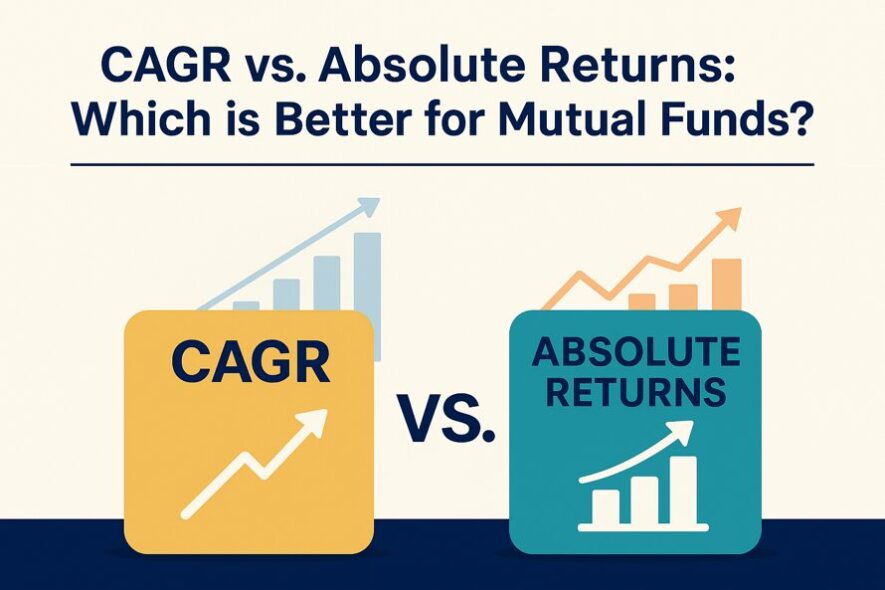SIP Calculator
×CAGR vs. Absolute Returns: Which is Better for Mutual Funds?

Introduction to Mutual Fund Return Metrics
When you’re scanning mutual fund performance, those glowing percentages can feel a bit tricky. One fund says it delivered 60%. Another flashes an 18% return. But here’s the catch—those numbers mean different things depending on the time frame and method used.
CAGR vs Absolute Returns is not just a math exercise. It decides how clearly you see your fund’s journey. One shows raw gains. The other smooths the path over time. To make smarter investment decisions, you need to know how these two metrics work, where they shine, and where they slip.
Let’s break this down for a better understanding.
What is Absolute Return?
“Start investing with confidence! Explore the best mutual funds and grow your wealth.”
Formula and Calculation
Absolute return is simple. It tells you how much your investment grew over a specific time period—without bothering about how long it took to generate the return.
Formula:
Absolute Return = [(Final Value – Initial Value) / Initial Value] × 100
Example:
You invest ₹1 lakh. It grows to ₹1.3 lakh in 18 months. Your absolute return is 30%.
There’s no compounding involved. Just calculating the net difference between start and end.
Use Cases for Short-Term Investments
This metric works great for short-term comparisons. Think 3-month or 6-month performance checks. If you’re reviewing the returns on a one-off investment or looking at very recent fund changes, absolute returns give a quick snapshot.
Fund managers also use it to highlight short bursts of performance—especially in volatile or high-growth phases.
Limitations of Absolute Return
But here’s the catch: absolute returns can’t show time efficiency. Two funds may show the same absolute return, but one did it in 6 months while the other took 3 years. That’s a huge difference—and absolute return doesn’t tell you that.
If you’re planning long-term investments, relying only on this figure will provide an incomplete picture.
What is CAGR (Compound Annual Growth Rate)?
Formula and Calculation Method
CAGR smooths out investment growth over a specific period. In other words, it is the average annual rate of return for an investment, assuming that profits are reinvested, or compounded, over time.
Formula:
CAGR = [(Final Value / Initial Value) ^ (1 / N)] – 1
Where N is the number of years.
Example:
₹1 lakh growing to ₹1.6 lakh in 3 years gives a CAGR of around 17%.
Even if the returns fluctuated every year, CAGR presents a steady average. It’s your go-to metric when analyzing long-term fund performance.
CAGR for Long-Term Investment Analysis
CAGR shines when you want to understand the sustained growth rate. It flattens volatility and offers a clearer trend line. If you’re comparing 3-year or 5-year performances across multiple funds, CAGR is what you want to look at.
It shows consistency, not spikes.
Limitations of CAGR
CAGR assumes a smooth, linear path. But markets are rarely that calm. A fund may swing wildly one year and still deliver a good CAGR. It also masks interim dips or recoveries.
So, while it’s excellent for high-level performance reviews, it doesn’t reflect market realities or volatility in real-time.
Key Differences Between CAGR and Absolute Returns
Time Period Consideration
Absolute return ignores how long it took to achieve the gain. CAGR underlines the investment period. That’s the core difference. If you only look at total return without context, you may miss how efficient (or slow) the growth was.
Time adds weight. And CAGR brings that weight into the equation.
Compounding Effect
CAGR includes compounding. Absolute return doesn’t.
Say your ₹1 lakh grows 20% the first year and 10% the next. Absolute return will be 30%. But CAGR will be around 14.89% annually. Why? Because it layers the gains year-on-year.
Compounding is where real wealth happens—and CAGR reflects that.
Interpretation Accuracy
CAGR is more accurate for long-term analysis. It’s what AMCs use in brochures and fact sheets when showcasing 3–, 5–, and 10-year performance. Absolute return works best when the time frame is fixed and short.
If you mix them up, you may end up comparing apples to oranges. Always check the time period before trusting a return percentage.
When to Use Absolute Returns vs. CAGR
Evaluating 1-Year Performance
If you’re just reviewing a fund’s 1-year record, absolute return is fine. Over such a short window, CAGR doesn’t add much clarity.
But remember: one good year doesn’t make a great fund. Use it as a checkpoint, not a decision point.
Comparing 3-Year or 5-Year Fund Performance
Here’s where CAGR becomes essential. When you’re looking at long-term trends, CAGR strips away the noise. It levels the field, especially when you’re comparing multiple funds that started or performed differently across the years.
Think of it as the investment equivalent of “average speed” on a long road trip.
SIP vs Lump Sum Investment Scenarios
SIP returns often need XIRR to capture cash flows fully. But in CAGR vs Absolute Returns, CAGR comes closer to painting the full picture for SIPs spread over time.
Lump sum returns are easier to track with absolute return—if held for a short, fixed time. But again, for longer durations, CAGR wins.
How Mutual Funds Present Return Data to Investors
AMFI Guidelines and SEBI Norms
Fund houses must report returns using standardized methods. SEBI mandates 1-year, 3-year, and 5-year CAGR disclosures. These give investors a clear view of fund performance across different holding periods.
You’ll rarely find funds showcasing absolute returns beyond 1-year windows—because CAGR tells a more complete story.
Interpreting Fund Factsheets and Disclosures
Factsheets typically show point-to-point CAGR, benchmark comparisons, and peer fund rankings. Use them to compare similar funds across categories.
Always check the “Since Inception” CAGR too—it gives a broader picture of how the fund has evolved.
Common Mistakes While Comparing Mutual Fund Returns
Ignoring Time Frame of Returns
Seeing “returns: 40%” on a banner means nothing if you don’t know the time frame. Was it over 1 year? 3 months? 4 years?
Always read the fine print. Numbers read in isolation can be misleading.
Comparing Incompatible Metrics
This happens a lot. You look at one fund’s CAGR and another fund’s absolute return—then try to pick between them. It’s like comparing miles driven to miles per hour. You need to compare both funds on the same scale.
Which Metric Should You Rely On More?
For serious decision-making, CAGR usually offers deeper insight—especially if you’re planning to hold your investments for a few years. It shows how well the fund sustains growth over time.
Absolute return is great for quick checks, marketing blurbs, or short-term wins. But for wealth building, CAGR gives the real pulse.
Best practice? Look at both. Use absolute returns for short snapshots. Trust CAGR to get the big picture.
Conclusion
In the CAGR vs Absolute Returns debate, context decides the winner. Both have value. Both reveal different aspects of performance.
If you’re comparing short-term movements, use absolute returns. If you’re mapping your money’s journey over time, use CAGR. And when in doubt, zoom out—long-term wealth is rarely built on one number.
Just remember: it’s not about finding the perfect metric. It’s about understanding what each number tells you—and what it leaves out.
FAQs
Q. What is better—CAGR or absolute return?
CAGR works better for long-term investments. It gives you a time-adjusted growth rate, making it easy to compare across funds and timelines. Absolute return is useful for short-term views or quick snapshots, especially under 12 months. For most mutual fund comparisons beyond one year, CAGR gives a clearer picture.
Q. Is CAGR always higher than absolute return?
No, not always. CAGR can be higher, lower, or equal to absolute return depending on the time period and compounding. Over short periods, absolute return may look bigger because it skips time adjustment. Over longer periods, CAGR reflects the compounded growth rate, which tells the real annual pace.
Q. Why do mutual funds show both CAGR and absolute returns?
Mutual funds show both because each serves a different purpose. Absolute return helps investors understand short-term growth (usually under 1 year). CAGR shows how the fund performed consistently over multiple years. Showing both adds transparency and enables you to pick based on your investment timeline.
Q. How do I calculate CAGR for my investments?
You need three values: your investment’s starting amount, final amount, and the number of years. Then use this formula:
CAGR = ((Final Value / Initial Value) ^ (1 / Number of Years)) – 1
Plug those into a calculator or Excel sheet, and you’ll get the average annual growth rate across the entire duration.
Q. Can absolute return be misleading?
Yes, if you ignore the time factor. A 25% return looks great, but if it took five years to achieve, it’s actually low on annual growth. Absolute return skips over compounding and time duration, which can be misleading when comparing funds with different timeframes.
Q. Does SIP use CAGR or XIRR?
SIP returns are better represented using XIRR (Extended Internal Rate of Return). That’s because SIP involves multiple cash flows at different times. XIRR gives you a more accurate view of your real return in SIP-based investments.




